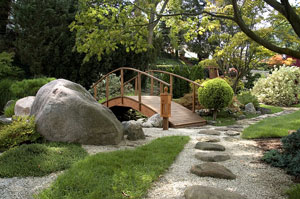
Story: Diane Norris
Photos: Peter Brennan
Sydney is blessed with plenty of bushland pockets scattered throughout its suburban areas. Further out, but not too far away, are several major national parks, including those of Wollemi, Blue Mountains, Boudii, and Ku-ring-gai-Chase. As our awareness of environmental and conservation issues increases, so too does the number of gardeners seeking to emulate such wild habitats in their own back (and front) yards to provide a safe haven for native birds and animals.
The leafy North Shore suburbs are renowned for their beautiful gardens, many of them of more traditional, formal style. Flourishing in their midst are the naturally styled gardens of Mary-Lou Lewis and her mother-in-law, Betty Lewis. While they may be different in design, topography and approach, the gardens are bound together by two common threads.
First, their purposes are the same: to provide a habitat that is attractive to wildlife by providing food, water and shelter. Second, each garden is a family affair. While not a unique concept, it is rewarding for families to bounce ideas off each other and have a common bond, in this case, a love of gardening and a love of nature.
Mary-Lou’s garden is adjacent to bushland in West Pymble and Betty’s is close by in Killara. Both enjoy regular visits from birds and animals and have evolved into environmentally sympathetic natural ecosystems in their own right. While both share similar ideals, their garden styles are quite different.
The West Pymble garden was originally very weed-infested, with privet, vines, fishbone fern and camphor laurels, so Mary-Lou’s priority was to cull these and establish the area with predominantly native plants that had absolutely no weed potential. The plants she used are low-maintenance, drought-tolerant and foster floral diversity.
“Living adjacent to the bush increased my desire to know the complexity of residential impacts on the natural environment. Reducing weed seed and stormwater impact on the bushland was my major aim,” says Mary-Lou.
To give refuge to insects, lizards and small birds, a layered planting approach has been adopted and a stroll around the garden reveals flowering Callistemon species, banksias (such as the bold Banksia robur), blueberry ash and grasses.
An old tree stump provides shelter for a wondering echidna, birds visit daily looking for insects or nectar, and Mary-Lou has even seen a Powerful Owl. This garden also looks after the smaller visitors, like native bees which have set up camp in a hive specially built for them.
One of the problems with storm water run-off in suburban areas is that it is full of nutrients, chemicals and particles that promote pollution in creeks and encourage the growth of non-native plants and weeds. This garden has addressed this problem, with all the stormwater run-off directed into a holding dam where these undesirable materials can settle. The garden is also cleverly landscaped to capture water so it is retained where it is needed.
Berms were built to direct overland flow to the garden beds and hard surfaces are kept to a minimum, which allows water to soak into the soil where it falls. The little ponds scattered throughout the garden are filled with water plants and provide hiding spots for fish, frogs and insects. There is also a resident red-bellied black snake near one of these.
Luckily, Mary-Lou was able to draw on the muscle power of her three sons for the tough jobs but thanks to what was clearly a family effort, the garden now looks like a natural bushland. This means it is not particularly structured, looking more like it is an extension of the bush. Large, natural stone is found in selected outcrops, there are huge weathered stone formations that could never be sculptured by even the finest of craftsmen, and the grasses, plants, groundcovers and trees look like they are self-seeded. The result is a garden that is, in Mary-Lou’s words, “locally native”.
Betty Lewis’s garden is just across the gully in Killara. While this garden has more of the look of an English wild garden, the philosophy and ethos is the same. The site was a standard suburban garden with lawn, trees and shrubs when Betty first formulated her plans for a “back to nature” makeover. Today it has a lovely meadow-like quality and travels through the changing seasons with grace and charm.
First, though, she had to improve the heavy clay soil with plenty of organic composts and manures. That done, Betty was able to start experimenting with plants — an experiment that continues to this day.
“When a plant has had its day and a change is needed, I find a new plant that will fit in that spot,” says Betty. In choosing plants, she is influenced by leaf shape, colour, flowering season and a plant’s ability to provide for the needs of the insects and small native animals to be found in the area.
There are flowering natives such as Grevillea ‘Moonlight’, grass trees and Eucalypt species intermingled with creepers, trees and shrubs that, even though non-native, provide shelter for animal visitors. “I cherish the beauty of our eucalypts. They have the ability to host wonderful native birds, an array of insects, and provide a hidden spot for micro-bats. There are native bees feeding off the eucalypt blossoms and insectivorous bats that visit to find food. They also provide a home for larger fauna species such as possums,” says Betty.
This garden is also used to grow vegies and herbs for the family, as is Mary-Lou’s, and offers up some quirky delights, such as stepping stones that meander through the undergrowth and statues.
Both these properties are nurtured by garden lovers who value and love nature. They appreciate the adverse impact suburbia can have on bushland areas and our wildlife. To some these gardens may appear overgrown, but as Mary-Lou says, the gardens are enjoyed by passers-by who often stop to comment on “this and that” and say how the profusion of green and the sight of birds flitting from branch to branch lifts their spirits.




